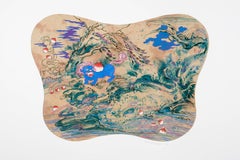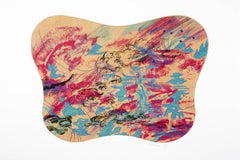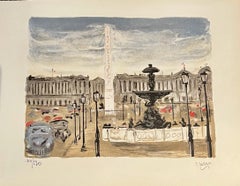Jiha Moon Art
American, Korean, b. 1973
Jiha Moon (b. 1973) is from DaeGu, Korea and lives and works in Atlanta, GA. She received her MFA from the University of Iowa, Iowa City. Her works have been acquired by Asia Society, New York, NY, High Museum of Art, Atlanta, GA, The Mint Museum of Art, Charlotte, NC, Smithsonian Institute, Hirshhorn Museum and Sculpture Garden, Washington, DC, Weatherspoon Museum of Art, Greensboro, NC and The Virginia Museum of Fine Arts, Richmond, VA. She has had solo exhibitions at Museum of Contemporary Art of Georgia, GA, Taubman Museum, Roanoke, VA, the Mint Museum of Art, Charlotte, NC, The Cheekwood Museum of Art, Nashville, TN and Rhodes College, Clough-Hanson Gallery, Memphis, TN and James Gallery of CUNY Graduate Center, New York, NY. She has been included in group shows at Kemper Museum, Kansas City, MI, the Fabric Workshop and Museum, Philadelphia, PA, the Atlanta Contemporary Art Center, Atlanta, GA, Asia Society, New York, NY, The Drawing Center, New York, NY, White Columns, New York, NY, Smith College Museum of Art, Northampton, MA, and the Weatherspoon Museum of Art, Greensboro, NC. She is recipient of prestigious Joan Mitchell foundation’s painter and sculptor’s award for 2011. Her mid-career survey exhibition, “Double Welcome: Most everyone’s mad here” organized by Halsey Institute of Contemporary Art and Taubman Museum has toured more than 10 museum venues around the country until 2018.to
2
2
Nahan's Forty Winks
By Jiha Moon
Located in New York, NY
In her image- and color-saturated paintings and prints, Jiha Moon mashes up materials, motifs, and techniques to create dreamlike compositions, stuffed with Eastern and Western art historical and pop cultural references that challenge fixed notions of cultural identity and represent our information-overloaded world. Everything is fair game for Moon—she draws from sources high and low, real and virtual, ancient and contemporary, including 13th-century Taoist painting...
Category
21st Century and Contemporary Contemporary Jiha Moon Art
Materials
Lithograph
En Route
By Jiha Moon
Located in New York, NY
In her image- and color-saturated paintings and prints, Jiha Moon mashes up materials, motifs, and techniques to create dreamlike compositions, stuffed with Eastern and Western art historical and pop cultural references that challenge fixed notions of cultural identity and represent our information-overloaded world. Everything is fair game for Moon—she draws from sources high and low, real and virtual, ancient and contemporary, including 13th-century Taoist painting...
Category
21st Century and Contemporary Contemporary Jiha Moon Art
Materials
Lithograph
$2,300
Related Items
Clemente Untitled B: surreal mythical landscape, voyage with ocean, Venus, snake
By Francesco Clemente
Located in New York, NY
A black and white, large-scale surreal mythical landscape of an ocean voyage, with a snake wrapped around a clock, a ship, Venus sculpture, greek urns, and snakes, printed in black o...
Category
1980s Contemporary Jiha Moon Art
Materials
Lithograph
$2,975
H 26.75 in W 119.25 in
La Place de la Concorde
Located in Belgrade, MT
This lithograph is a part of my private collection from the early 1970's. It is artist pencil signed in the lower right corner, and numbered in the lower left.
Published : Guild de l...
Category
Mid-20th Century Contemporary Jiha Moon Art
Materials
Oil, Lithograph
$385 Sale Price
30% Off
H 8.25 in W 10.75 in
Equestrian Scene
Located in Belgrade, MT
This lithograph is a piece from my private collection of 20th Century School of Paris era artists. It is hand signed by the artist and numbered, Guilde de la Gravure, and is in very ...
Category
Early 20th Century Contemporary Jiha Moon Art
Materials
Oil, Engraving, Lithograph
Robert Burkert Lithograph Landscape "Late Light" Poetic
By Robert Burkert
Located in Detroit, MI
"Late Light" by Robert Burkert is a lithograph landscape by the master printmaker that depicts a clearing with autumn/winter trees in the subtle but vib...
Category
Late 20th Century Contemporary Jiha Moon Art
Materials
Lithograph
$1,500
H 28.5 in W 37.25 in
The Gates Project for Central Park, New York (18370)
By Christo and Jeanne-Claude
Located in New York, NY
Serigraph
Signed in pencil
Category
21st Century and Contemporary Contemporary Jiha Moon Art
Materials
Screen, Lithograph
$6,900
H 28.5 in W 40 in
Tall Trees
Located in Llanbrynmair, GB
’Tall trees’
By Jamie Boyd
Medium - Lithograph
Edition - AP
Signed - Yes
Size - 635mm x 870mm
Date - c1975
Condition - Good. 9 out of 10.
Colour of print m...
Category
1970s Contemporary Jiha Moon Art
Materials
Lithograph
Canaletto
By Patrick Hughes
Located in London, GB
A hand painted three dimensional, Reverspective print, inspired by Venice. Produced in 2024. This print comes housed in a bespoke perspex display case. A limited edition of 75.
Hand...
Category
2010s Contemporary Jiha Moon Art
Materials
Lithograph, Offset
Bush scene with blue and yellow
Located in Llanbrynmair, GB
’Bush scene with blue and yellow’
By Jamie Boyd
Medium - Lithograph
Edition - AP
Signed - Yes
Size - 630mm x 865mm
Date - c1975
Condition - Excellent. 10 out of 10.
Colour of print...
Category
1970s Contemporary Jiha Moon Art
Materials
Lithograph
Waterfall
Located in Llanbrynmair, GB
’Waterfall’
By Jamie Boyd
Medium - Lithograph
Edition - AP
Signed - Yes
Size - 635mm x 870mm
Date - c1975
Condition - Good. 8 out of 10.
Colour of print may not be accurate when vi...
Category
1970s Contemporary Jiha Moon Art
Materials
Lithograph
The Lighthouse - Mandela, Former South African President, Signed, Robben Island
By Nelson Mandela
Located in Knowle Lane, Cranleigh
Nelson Mandela, The Lighthouse, Signed Limited Edition Lithograph
Many people are unaware that Nelson Mandela turned his hand to art in his 80's as a way of leaving a legacy for his family. He spent time with an art tutor and learnt to draw. In 2002, when creating the The Lighthouse print...
Category
Early 2000s Contemporary Jiha Moon Art
Materials
Lithograph
$12,079
H 19.69 in W 22.05 in D 1.58 in
bridge and river lithography artwork abstract expressionism
By Jose Antonio Herrera Alcazar
Located in Sitges, Barcelona
Jose Antonio Herrera Alcazar was born in 1960 and was largely influenced by the 1970s. The art sphere of the 1970s was epitomized by a longing to evolve and reinforce itself, as a re...
Category
2010s Contemporary Jiha Moon Art
Materials
Lithograph
$237 Sale Price
33% Off
H 8.27 in W 11.03 in
Flowers
Located in Llanbrynmair, GB
’Flowers’
By Jamie Boyd
Medium - Lithograph
Edition - AP
Signed - Yes
Size - 635mm x 870mm
Date - c1975
Condition - Very good. 9 out of 10.
Colour of print may not be accurate when...
Category
1970s Contemporary Jiha Moon Art
Materials
Lithograph
Jiha Moon art for sale on 1stDibs.
Find a wide variety of authentic Jiha Moon art available for sale on 1stDibs. You can also browse by medium to find art by Jiha Moon in lithograph and more. Much of the original work by this artist or collective was created during the 21st century and contemporary and is mostly associated with the contemporary style. Not every interior allows for large Jiha Moon art, so small editions measuring 20 inches across are available. Customers who are interested in this artist might also find the work of Claire Sherman, Maria Rivans, and Rafael Ferrer. Jiha Moon art prices can differ depending upon medium, time period and other attributes. On 1stDibs, the price for these items starts at $1,400 and tops out at $2,300, while the average work can sell for $1,850.



